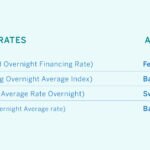The end of LIBOR is approaching
The reform of the benchmark interest rates known as InterBank Offered Rates (IBOR) is one of the most significant financial reforms at present. It was driven by both international organizations (IOSCO and FSB) and regulators (Benchmarks Regulation 2016/1011), with the goal of making the market more transparent and robust. This has led to the incorporation of substantial changes in the interest rates used as benchmarks in the operations of financial and non-financial institutions.

We will analyze the main aspects of this major reform, with a focus on the challenges facing global transactional banking. Both financing products, like credits or discounts (factoring, supply chain finance and trade finance) and savings products like deposits will be affected.
It should also be noted that, within this broad reform, a specific interbank rate, LIBOR, is of particular interest as it is the most commonly used as a reference, especially LIBOR USD.
What does this reform entail?
The first aspect to take into consideration is that LIBORs will cease to exist. Starting January 1, 2022, LIBOR, GBP, CHF, JPY and EUR can no longer be used, as well as the one week and two month tenors of the USD LIBOR. The more frequently used tenors of the USD LIBOR (3, 6 and 12 months) will be discontinued as of June 30, 2023, although regulators are accelerating restrictions on its use starting in 2022. EURO linked transactions will experience less of an impact as the EURIBOR has been transformed in order to comply with the new regulations, and for now, it is not expected to end.
The disappearance of these LIBORs is not the only novelty. The different regions have worked to propose alternative benchmark rates. Therefore, it will become increasingly more natural to refer to SOFR, SONIA, SARON y TONA, - what we call ‘Risk Free Rates’ (RfR).
Are there differences between RfRs and LIBORs?
Definitely, yes, mainly in two aspects. First of all, RfRs have no term risk. They are overnight rates, while LIBORs have more tenors available (one, three or six months, for example).
Second, the RfRs also do not have the credit risk component that LIBORs have. Therefore, there is a need to make these overnight rates compatible with the longer tenors (1, 3, 6, 12 months) that are used in transaction banking operations, which we were used to with LIBOR.

Recommended alternative benchmark rates.
Furthermore, it is important to keep a third consideration in mind. In the family of transaction products for companies and large corporations, it is normally necessary to know the interest rate to be applied since the start of the interest accrual period, something that the LIBORs also resolved. This is fundamental in discount products like factoring.
In order to address these three challenges, the industry has worked on different alternatives to calculate the interest rate to apply:
- Based on historical data, or a backward-looking structure. The interest rate to apply is calculated as an average of the daily RfR values. The value calculated from this is applied to the interest period. Therefore, the interest rate is known from the start. This calculation convention is known as ‘in advance’.
- Based on future data, or a forward-looking structure. It consists of term rates, whose application mechanism and structure is similar to the LIBORs. These term rates are a reflection of a forecast for the period to which the rates refer. The administrators who make these indexes build them based on real operations from the derivatives market on RfRs for the given period. Therefore, they provide rates for future terms, and comply with regulators’ stipulations.
There are two types of term rates, backed by the working groups, for the following currencies:
- USD: Term SOFR de CME Group
- GBP: Term SONIA de Refinitiv y Term SONIA de ICE Benchmark Administration
- JPY: Term TONA (TORF) de Quick Benchmarks Inc.
It is also necessary to manage the credit risk when pricing the transactions. A possibility that the working groups for the different currencies offer is adding a fixed credit adjustment by currency and tenor, which the International Swaps and Derivatives Association (ISDA) calculated, and was set on March 5th 2021.
Without a doubt, this is a highly significant financial reform that affects the financing of global trade. BBVA is prepared and continues working to facilitate the transition in our clients’ operations - both now, in contracts currently in force that are referenced to LIBORs, and in the future, to adapt to the new environment.
Daniel Saeta, Strategy & Business Development at BBVA Global Transaction Banking.